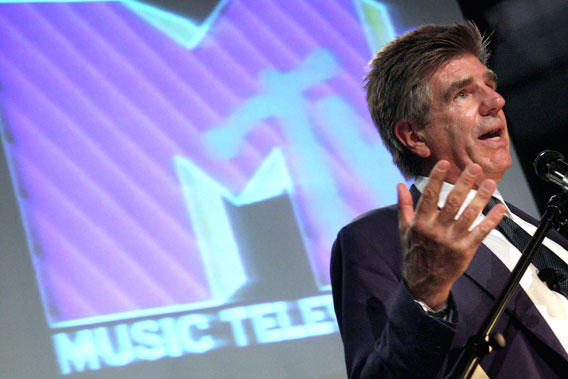He Made Them Want Their MTV
When the music video network was launched in 1981, industry insiders didn’t give it a chance, but co-founder Tom Freston had the last laugh
By Helene Ragovin
Twenty-seven years ago, a grainy image of a rocket launch flickered onto America’s TV screens. There was a countdown, then the words: “Ladies and gentlemen, rock and roll”—followed by the opening chords of the New Wave hit Video Killed the Radio Star.
And so on August 1, 1981, MTV was born.

“You may love it or hate it now, or not care, but MTV blazed the way for what was to follow,” Tom Freston said at the Snyder Presidential Lecture. Photo: Bethany Versoy
“It’s hard to believe now, but it was a revolutionary thing when it first came out,” says Tom Freston, one of the founders of MTV, and the speaker at the ninth Richard E. Snyder Presidential Lecture.
The Snyder Lecture is devoted to achievers who have made their mark by challenging conventional wisdom. Back in the early ’80s, when cable television was still virgin territory, it was indeed a gamble whether a round-the-clock “radio station” that put pictures to the music could capture the attention of its target audience—college-age kids—and become commercially viable.
Of course, MTV not only met that goal—it also ended up changing the world of music, television and youth culture.
“It was at the time a great example of what people called ‘new media,’ ” said Freston, who went on to become chair and CEO of MTV Networks and later was president and CEO of Viacom. “In the days before digital, back in the ’80s, new media really meant anything to enhance or improve or surpass any existing technology that was out there.
“People love new media. And each generation seems to get some. My parents got TV, which actually was a new medium. You can imagine, in the late ’40s, early ’50s, you got a box in your living room, and the whole world could come through it. It just blew your mind,” he said. In the 1960s, the new media was FM radio; in the 1970s, it was HBO.
When Freston and his colleagues developed the original format for MTV, they were, more or less, flying by the seat of their pants. The venture had corporate backing from Warner Communications and American Express. But the channel was cobbled together, with pizza-fueled all-nighters in hotel rooms—scenarios not unlike those that repeated 20 years later at dot-com start-ups—by a group of TV industry novices.
Broadcast industry insiders “used to laugh at us,” Freston recalled. “There was a smart reason not to hire anyone at MTV who had ever worked in TV before,” he said. Freston himself, for example, spent the ’70s launching textile business ventures in Afghanistan and India. “They didn’t want anyone to bring the prejudices, preferences or bad habits of spending lots of money” from broadcast.
“It was really the first sort of non-narrative form of TV,” Freston said. “We wanted to be sort of subversive, non-corporate—have a style that in a way sort of reminded us of what that early FM radio was like in the ’60s.”
MTV started with a rotation of just 120 videos. But “the people who watched the channel loved it,” Freston said. “The problem was, hardly anyone got MTV” because cable companies were reluctant to offer it.
“The fact is, most people, you will find, resist innovation,” Freston said. “They will say it doesn’t work; they will say it doesn’t make sense.”
So, in another innovative move, MTV launched a “Hail Mary” pass, and went over the heads of the distributors, straight to the consumers, with the now-classic “I want my MTV!” ad campaign. “Those commercials saved the day for us,” Freston said. “It was one of the most successful TV campaigns ever. We rolled across the country, adding millions of customers a month. That campaign kept the wolf from the door and made us famous.
“You may love it or hate it now, or not care, but MTV, along with some of its compatriots like CNN, blazed the way for what was to follow,” said Freston, who is now a principal in Firefly3, a consulting and investment media company, and chair of the ONE Campaign, a bipartisan advocacy organization devoted to fighting poverty and preventable disease.
MTV and its “new media revolution” have also provided a number of lessons that can be applied in today’s media world, Freston said:
- In a new category, good competitors can help create the category.
- If you’re involved in an innovative venture, you want a staff of “fanatical crusaders, true believers, who will meet resistance and overcome it.”
- Incumbents are basically slow; your competitors will underestimate you.
- Good brands are worth more than ever. The more choices that are out there, the more power a brand has, because it becomes a shortcut for the consumer.
- In a creative business, do the creative work in-house in the beginning, so it can take the form that you want it to.
“New media,” Freston said, “just keeps getting newer, more powerful, more transformative than it’s ever been.”
Watch a video of the lecture.Helene Ragovin may be reached at helene.ragovin@tufts.edu.


